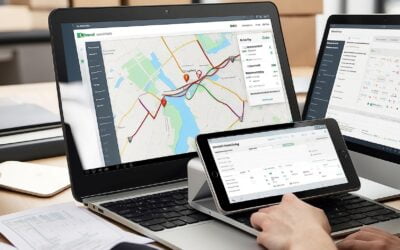Equipment checkout software helps you keep track of your equipment hires and bookings. This way, you can keep a closer eye on where your assets are and who they’re with.
With equipment checkout software, you can schedule maintenance downtime and create bookings to show when assets are due to be unavailable. This creates a full level of transparency for your team when it comes to shared assets.

How Does Equipment Checkout Software Work?
Equipment checkout software works by using asset tracking software principles. Your equipment checkout software will have a backend where you can create and log critical asset information, giving you a highly scalable and streamlined system.
In other words, you’ll be able to log each of your assets in individual profiles and add data to these profiles. So, if you’re using equipment checkout software in tandem with tools and equipment tracking systems, you’ll be able to perform these operations in a single system.
This way, each tool has a helpful feature where you can add information with ease. So, the next step is to click a button to either book or check out that tool.
How To Use Equipment Checkout Software
Equipment checkout software is simple to use. First of all, you will need to log your asset register. This will have many speed and ease of use functions, such as the ability to bulk add and bulk clone assets.
You can then use asset tags to speed up your operations, too, but this isn’t necessary. Asset tags are physical tags that you use to link your physical assets to their digital profiles in your asset tracking system.
Once you’ve added and tagged your assets, the process of booking them and checking them out is simple. Scan the tag and press “book asset”.
When you use asset tags you can create bulk bookings with ease, too. In other words, you can scan a group of asset tags to add them to a booking, saving you time in the process.
Tracking Your Assets
There are scalable systems within your equipment checkout software, too. In essence, as you’ve added your assets, you can add any data you need to against them.
Therefore, you can create effective workflows surrounding your bookings process. As an example, you can report an issue and schedule in downtime with a booking in a few clicks.
Then, whenever you need to, you can export reports of all of your asset data. This will include asset locations, asset issues, asset maintenance, and bookings.
A report of your data is incredibly handy for tax and insurance processes as it shows that your assets exist, are in use, and are responsibly managed.
itemit’s Booking And Check In Check Out Software
itemit’s booking and check in check out software gives you a wide range of features. At its core, the system allows you to log unique assets and add data to them. This data can be anything you need to track.
So, when you use itemit, you get a single, centralised system where you can log, monitor, track, and update your assets. This creates an automated, transparent and effective asset register, reducing the chances of any gaps in your asset management operations.
Overall, itemit is a scalable system that you can use for fixed asset management, IT asset management, equipment bookings, and tools and equipment tracking, all at the same time.
To find out more about how itemit’s check in check out software can help you, you can contact the team at team@itemit.com or fill in the form below to start your very own 14-day free trial.
Equipment Checkout Software
Choose a better way to track your assets
Start your free 14-day trial now
Instant access. No credit card details required.
Related articles
How To Conduct an Asset Audit: Program Guide
Organisations that hold assets on their records must be realistic about their business environment, which is bustling today, particularly in the long run. An asset audit is a crucial process that helps businesses maintain control, optimise performance, and comply with regulatory standards. Whether you are managing a small start-up or leading a big corporation, knowing how to conduct an asset audit effectively will go a long way in determining the financial health of your organisation. This...
Asset Impairment. A Guide to Tracking and Managing
The competitive business environment requires maintaining accurate financial records. This is where asset tracking becomes crucial, ensuring that your assets are accurately accounted for and valued. Effective tracking solutions help identify impaired assets promptly, preventing financial discrepancies. This guide provides a comprehensive overview of tracking and managing asset impairment to safeguard your business's financial health.Understanding Asset ImpairmentWhat is asset impairment? It is...
Top Benefits of Using Inventory Management for Bakeries
Inside these bustling bakeries, redolent with the smell of freshly baked bread and sweet pastries, it takes more than delicious recipes and skilful hands to make a difference. Backing that perfect loaf or the lavishly decorated cake is a meticulous process for monitoring ingredients, supplies, and products. This is where inventory management steps in - the unsung hero of the baking world. While it is the artistry of baking that captures customer hearts, efficient inventory management ensures...



